1.
Saigon / Ho-Chi-Minh City
Saigon is Vietnam's largest city. It lies closely north of the Mekong Delta at the banks of Saigon River. Between 1954 and 1975 it was the capital of the state of South Vietnam. After the American Vietnam War it was renamed to Ho-Chi-Minh City. The name 'Saigon' is still in use, though. The former, traditional name of the city was Prei Nokor (also: Prey Nokor). Nowadays it's a booming industrial city with approximately at least eight million inhabitants. Other sources count the population of Saigon metropolitan area up to ten millions, and demography predicts a population in 2025 of 13.9 millions, and that is still a conservative number.
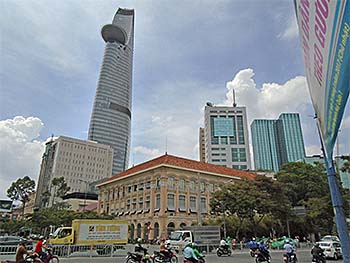
Completed in 2010, Bitexo Tower was the tallest building in Vietnam. Now it's on place 3 nationwide, and still one of the tallest buildings in the world. It's property of Bitexo, an multi-industry corporation. With a height of 262.5m it has 68 storeys. In the 50th to 52nd storey is a restaurant / bar wich offers a 360 degree panorama view over central Saigon. The elevator makes 7m per second, but being in the lift one does not feel neither the acceleration nor the speed. To reach the restaurant, there is also a helicopter platform implemented. Image by Asienreisender, 3/2017
The whole city area is a huge urbanized landscape which stretches over almost 50km in east-west direction and about 120km in north-south direction. Insofar is the place comparable with a whole, densely populated province.
It's still shining through, that Saigon once was a town with an attractive city center. The old buildings from the French time are still kind of pearls of the city. But modern city architecture and building boom has changed it into another urban nightmare of our times.
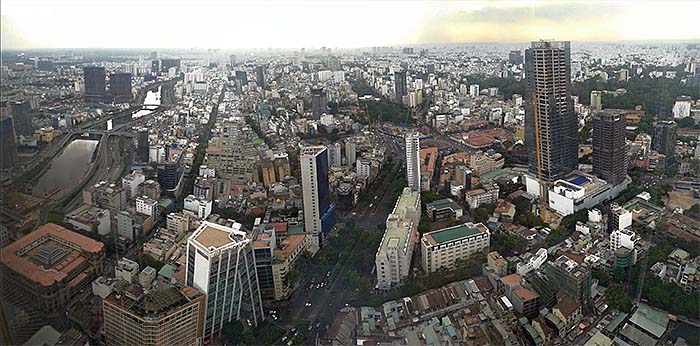
View over Saigon center with district one, seen from Bitexo Financial Tower westwards. Image by Asienreisender, 3/2017
2.
History
The foundation of Prei Nokor (Saigon) dates back into the time of the empire of Funan (first half of the first millenium). Later, the little fishing village came under the influence of Chenla and then a small outpost of the empire of Angkor. Due to it's favourable position on firm ground just north of the swampy Mekong Delta, Prei Nokor developed to a trade center for seafarers from far away countries like India, Indonesia, Malaysia and China. Foreign merchants settled down and Prei Nokor was promoted up to a garrison place.
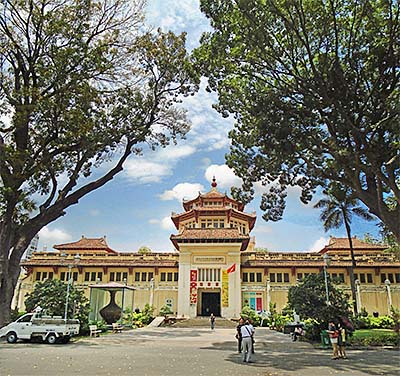
At the entrance of Saigon Zoo is the History Museum placed, in which a number of artefacts from early Vietnamese history up to the end of the colonial time are displaced. Unfortunately, the museum is closed over noon for two hours. Who will wait for so long? Image by Asienreisender, 3/2017
At the end of the 17th century, the Vietnamese conquered the Champa empire and took over the region. The Vietnamese nobleman Nguyen Phuc Chu from the ruling class of Hue organized from 1698 CE on a new administration system in Prei Nokor, which name was changed then into Gia Ðinh. Gia Ðinh was actually the name of a citadel built in the time. However, the name Saigon was used from the early time of Vietnamese colonization on as well.
After a rebellion in Hue in 1771, the Vietnamese ruler Nguyen Phuc Anh fled to Saigon and made it his new capital. The town got equipped with a fortification. In the further course of the conflict with Hue were also for the first time French military units involved. The French tried already to establish a firm trade post here. The struggle between the French and the Vietnamese lasted over decades until Saigon was militarily captured in 1859. It came with a terrible massacre which made the French looking quite bad in the region at the time. The French explorer Henri Mouhot gave an outline of the events in his travel narrative 'Travels in the Central Parts of Indochina'. Saigon became the capital of the new French colony Cochinchina. The French called the city then officially Saigon.
The French administration developed the city and coined it until today, draining the swamps, building dams, roads, a railway line and a number of public and private buildings, implementing an advanced traffic system. Like Phnom Penh, Saigon became a pearl among the Asian cities. Peter Scholl-Latour described Saigon as the most elegant and cultivated city in Asia (see: 'Der Tod im Reisfeld - 30 Jahre Krieg in Indochina').
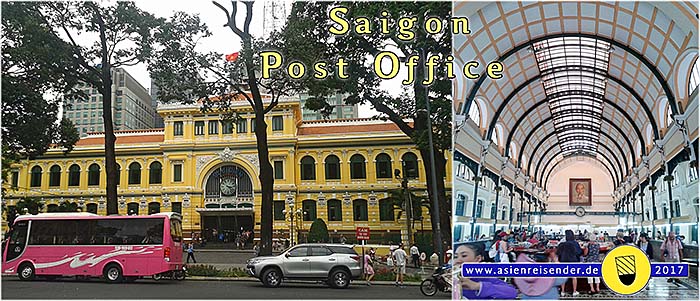
The main post office of Saigon was built around 1890. The construction was designed by Gustave Eiffel. Not knowing what it is, after entering the large building my first question was: Where are the platforms? But it didn't look much for a railway station anymore. However, it once was and got changed it's function. Image and photocomposition by Asienreisender, 3/4/2017
At the end of the Second World War in Asia (August 19th, 1945), the Viet Minh took over power in Vietnam. Ho Chi Minh declared Vietnam's independence on September 2nd, 1945. However, the French came back with British support to reclaim the country as their colony, which led to the First Indochina War (1946 - 1954). The French lost the war finally at Dien Bien Phu in 1954. Then Vietnam got parted into north and south; Saigon was now the capital of the south.
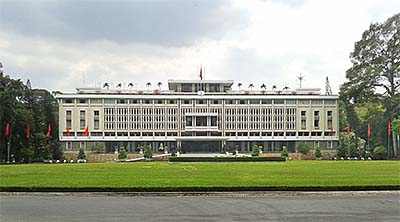
The so called 'Reunification Palace' or also 'Independent Palace' is actually the former presidential palace of South Vietnam. It's a concrete construction from the 1960s. From 1871 on there was the French colonial general-governor's villa and residence on the grounds, but this building got heavily damaged by an attack in 1962 and then demolished. Now there is another museum inside this modernist building. Image by Asienreisender, 3/2017
Never ceasing tensions between north and south and the fatal involvement of the USA led to the Second Indochina War (American Vietnam War). American troops were stationed in the ten thousands in Saigon. Drug trade and prostitution boomed, while the US Air Force bombed the country. Millions of war refugees came into the city. Finally America lost the war; the last dramatic event was the evacuation of the American embassy in April 1975 (called 'Operation Frequent Wind').
After 1975 a time of economic stagnation followed. An economic boom was initiated after the introduction of a liberalization from 1986 on. It's coming with the dirty growth of traffic, real-estate industries, corruption, prostitution, criminality, drug-trade, organized crime, HIV-infections and more of the kind.
The population boom in Saigon is characteristic for the boomtowns in Southeast Asia in general. While there were merely 7,000 people living here in 1862, the number rose to 100,000 in 1914, to 500,000 in 1939 and to 2,000,000 in 1974. Now, in 2017, it's about eight million people.
87% of the population are ethnic Vietnamese, 11% oversea Chinese. Minorities are Khmer, Cham and others.
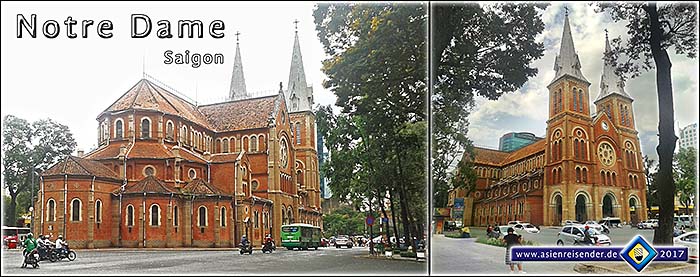
Another building from the French time is this Catholic brick cathedral, called Notre Dame, after it's big model in Paris. Image and photocomposition by Asienreisender, 3/4/2017
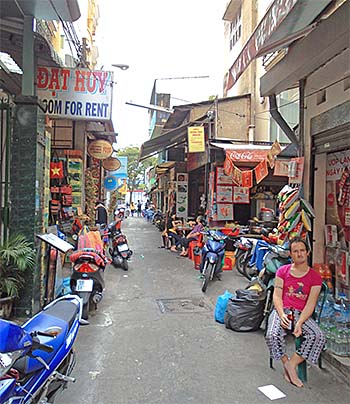
Inmiddle of district one. Image by Asienreisender, 3/2017
3.
District One
The center of the city is also the heart of the touristic center of Saigon. Besides, the most remains of French architecture and a number of more sights are around here in walking distance. In a heavily crowded road called 'De Tham' and surrounding alleys are many cheap hotels, guesthouses, bars, restaurants, tourist shops and travel agencies who organize easy transport to other places in south Vietnam. An aggressive and fraudulent business scene rules, competition is high. The restaurants are filled with shady and broken Westerners, many of the kind who have their first beer right after waking up, at whatever time that may be.
4.
Traffic
Individualized traffic is one main problem in the world. It's chaotic, dangerous and wasteful, and very destructive. It simply doesn't work, generally spoken. Here in Saigon it's rampant. The amount of motorbikes and cars is overwhelming, and the driving style is often pretty aggressive, speeding is usual. Any roadcrossing is a risky adventure for a pedestrian, one has to fight for one's life. Also on the sidewalks no one is safe, often flocks of motorbikes rush over them and there is no place anymore left where one could find a safeplace. Motorbikes even go into the smallest alleys, market places and very crowded areas.
Here and there is traffic police posted, but they don't care for all the wrongdoing and speeding on the sidewalks. One wonders for what they are good then.
5.
War Remnants Museum
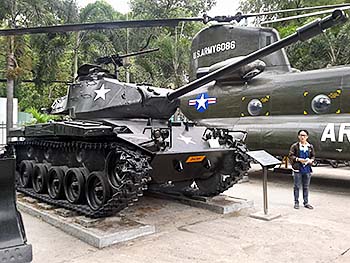
Plenty of captured American armament is displayed in the War Remnants Museum's garden. Image by Asienreisender, 3/2017
It's a place where daily many visitors go. Many Westerners and groups of Asians fill the spaceous rooms of the War Remnants Museum. It's covering three levels in a modernist building. In the museum's garden are plenty of American war vehicles displayed, a few aircrafts, a tank, a mobile artillery, a huge transport helicopter and much more. Also in the garden is a political prison section of the museum, where it's displayed how the American-backed south Vietnamese regime tortured it's political opponents. There is no word lost on how communist Vietnam dealt and deals with it's political dissidents.
Inside the main building are about a dozen rooms occupied with war remnants, but most of what is displayed here are photos on the walls. Two or three TV sets show documentaries.
For being a place so crammed with visitors, it's questionable why they do close the museum over noon for two hours. The cashier tried to take advantage of me when paying the fare, trying to sell me a book without asking and taking the price for it from my change.
6.
Saigon Zoo
A quiet and green place to go is the zoo. It's a great park inmiddle of the city. Many grand, old trees are still alive here - remains of the old times, when the Mekong Delta was still overgrown widely with tropical rainforest and mangrove forests. One can barely imagine that anymore, seeing all the heavy urbanization and industrialization.
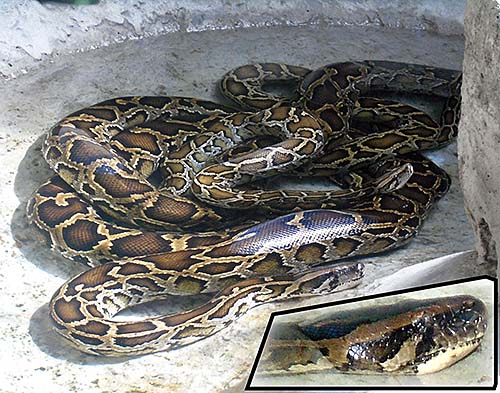
There is about a dozen of reticulated pythons in the zoo. Image and photocomposition by Asienreisender, 3/4/2017
Not too many people go there, mostly, as it seems, locals. Yes, zoos are places where families go, and a lot of kids are around. Nowadays, many of the Animals of Southeast Asia are, sad enough, only to see in the zoos anymore. And many of the good, old aquaintances appear there, that's the Indochinese tiger, pileated gibbons, Indochinese leopards, Malayan sunbears, hornbills, lesser adjutants, and many more. There are a lot of terrariums where many reticulated pythons are to see, monitor lizards, Siamese crocodiles, even a tokay gecko appears, Oriental small-clawed otters, porcupines, different kinds of civets like small and palm civets (but no large Indian civet). The smaller langures are able to leave the cages, they make it through the grid. Also other zoo animals I saw walking freely around; anyhow they managed to leave their cages.
Alltogether, the place is not too clean and sometimes there are no information signs about the animals. Where are informations, they are merely in Vietnamese. It's also a pity that many of the animals are kept behind thick glass windows; the reflections in the strong tropical sun make it very difficult to watch them. I saw a number of rats around in bright daylight, who enter some cages and feed from the other animals food. Goodness knows what's all going on there at nighttime.
Inside Saigon Zoo
Animals of Saigon Zoo
Asmall choice of the animals kept in Saigon Zoo. The one on top of the photocomposition is a palm civet.
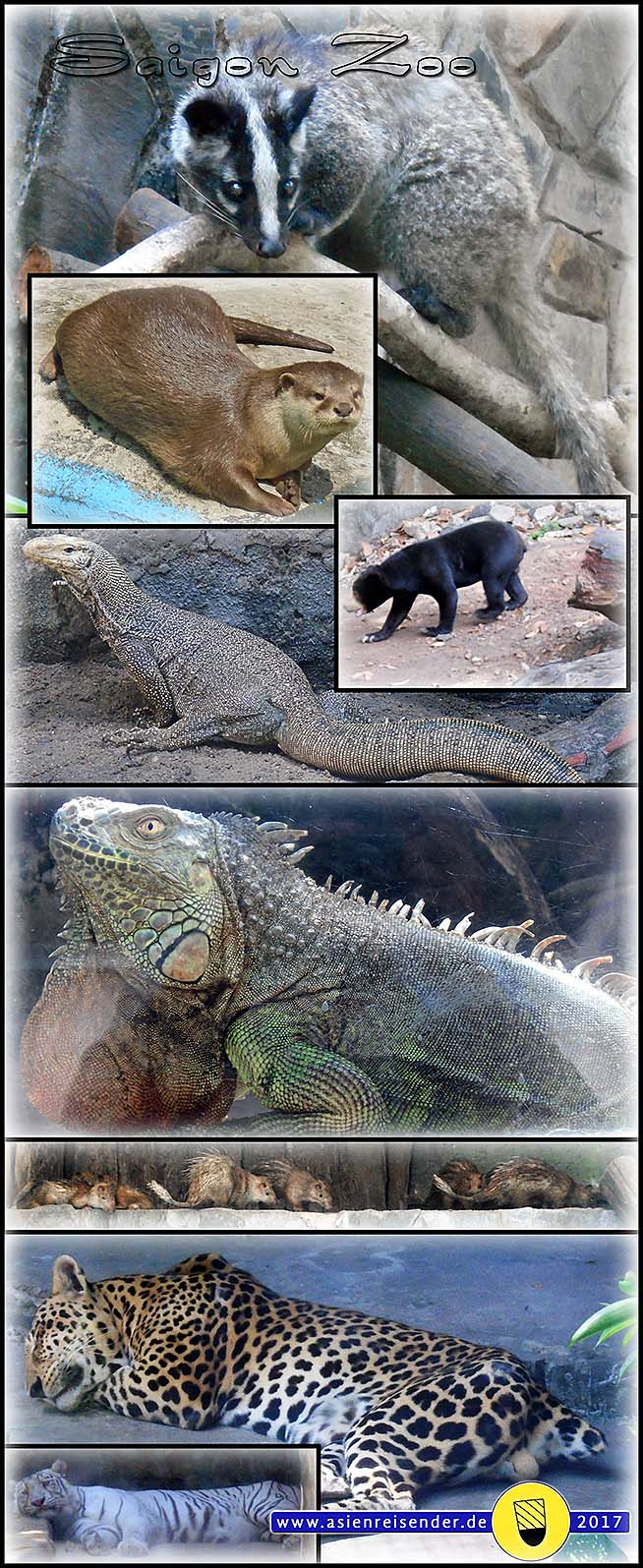
All images and photocomposition by Asienreisender, 3/4/2017
7.
Ho Chi Minh Museum
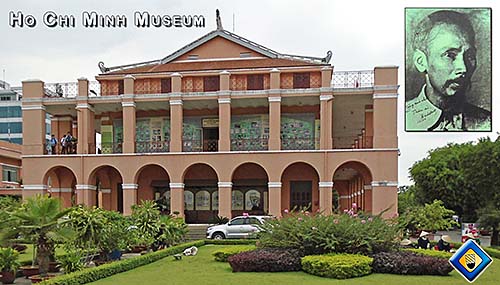
At the banks of Saigon River with a garden and a pretty big parking lies the Ho Chi Minh Museum. The photo of Ho Chi Minh is one of many photos of him inside the building, shot in 1946. Image and photocomposition by Asienreisender, 3/4/2017
In a bigger, representative building, the former duty administration of the colonial government from 1863, at the banks of Saigon River, is the museum for the overfather of communist Vietnam, Ho Chi Minh, placed. Like the War Remnants Museum it does not show many real items but merely many photos with short captions as explanations. The focus lies on the independence war and the American Vietnam War. No film documentary is given here. It's rather a poor presentation and seems to be designed for Vietnamese school classes to go here.
Ho Chi Minh - An Outline
Ho Chi Minh (1890 - 1969) was a Vietnamese revolutionary, communist politician, primeminister (1945 - 1955) and president (1945 - 1969) of the Democratic Republic of Vietnam. He is the most honoured personality of official Vietnam. Pictures of him are to find all over the country, particularly in all administration offices, post offices, army buildings, police stations, etc.
After studying for times abroad, particularly in Paris, London, New York, Boston and Moscow, he was one of the founders of the Communist Party of Indochina. He was also the leading Vietnamese fighting the Japanese occupation which cooperated with official Vichy France in the Second World War, opposing the French trial to re-capture Vietnam after the Second World War (First Indochina War 1946 - 1954) and the American Vietnam War (Second Indochina War (1964 - 1975), which end he didn't outlive. In 1946, the former South Vietnamese capital Saigon was officially renamed Ho-Chi-Minh City.
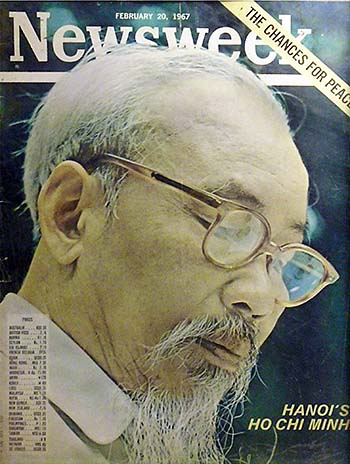
Ho Chi Minh on the cover of Newsweek in February 1967. In 1998, Time Magazine chose Ho Chi Minh as one of the one hundred most influential people of the 20th century. Image by Asienreisender, Ho-Chi-Minh Museum, 3/2017
Ho Chi Minh is one of about fifty pseudonyms he used in his life. 'Ho' means 'clear will'. In Vietnam, he is still often referred to as 'Uncle Ho' (Bac Ho). Due to his decades-long underground activities and the fact that numerous secret services where after him, he changed his names often. His childname was Nguyen Sing Cung, the name he used while his early travels to Europe was Nguyen Tat Thanh, a later name was Nguyen Ai Quoc (Nguyen the patriot).
After his time abroad, Ho Chi Minh came back to Vietnam in 1941, co-founded the Viet Minh and became their leader. He led the military operations against the Japanese army and the French administration. Interestingly, in the last months of the Second World War, from March to August 1945, the Viet Minh were official allies of the Western powers and supported by the OSS (the predecessor of the CIA).
The occupation of south Vietnam by British and later French troops in 1945 led to heavy clashes with Viet Minh. The conflict transformed into the First Inochina War after the French bombing of Hai Phong, where 6,000 civilians died.
After the victory over the French, Ho Chi Minh was one of the leading personalities to continue the struggle for the unification of north and south Vietnam. Since the Americans supported the South Vietnamese regime, the American Vietnam War escalated into the biggest desaster yet in Southeast Asia's history. Ho Chi Minh died in 1969, years before the war ended.
Together with Che Guevara and other leading heads of liberation movements in the colonialized parts of the world, Ho Chi Minh became worldwide famous. "Ho-Ho-Ho - Ho Chi Minh!" was an often heared call on demonstrations in West Germany in the 1960s. There is a considerable amount of literature written on him. His long-time credibility was underlined by his personal, modest life style. Ho Chi Minh lived most of his time in simple housings, even being president he stayed in a simple shack near the government building in Hanoi. Still now in de-facto capitalist Vietnam, Ho Chi Minh is a father-figure of the nation. However, his legacy is subject to a state propaganda which does not fit to the simple life style he followed, as for example expressed in the Ho Chi Minh Mausoleum in Hanoi, which follows the style of the Lenin Mausuleum in Moscow.
See also: The Ho Chi Minh Museum in Nakhon Phanom
8.
Geological Museum
Just by chance I ran into the Geological Museum of Saigon, for it was on the way to Ho Chi Minh Museum. Entering the building, a woman welcomed me and opened the door to an exhibition room. There was a collection of most different minerals and all around the walls again plenty of photos, drawings and paintings, illustrating geological history and also the history of early hominids. It's a dusty room and I was the only visitor. When leaving, I was asked to add my name to a list of who my inscription was the second. No entrance was charged. People are not interested in sciences.

Images and photocomposition by Asienreisender, 3/4/2017